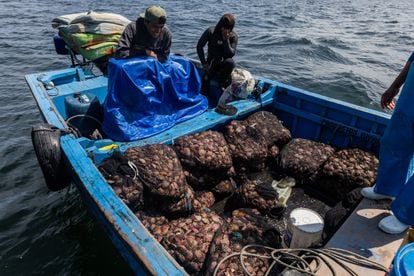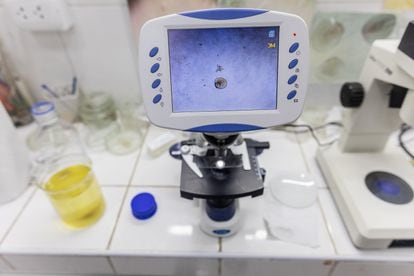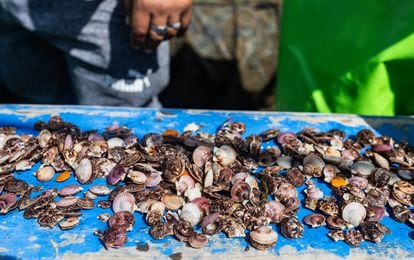EL PAÍS offers the América Futura section openly for its daily and global information contribution on sustainable development. If you want to support our journalism, subscribe here.
Despite the fact that some bumps shake the boat in which she floats a few miles from the coast, Mrs. Yanina Lisma Ramírez manages to begin to take out of the water a kind of white conical-shaped bag, called a 'plankton net' with a mesh it is just 110 microns that carries a revealing sample. “Temperature 22.5 degrees Celsius, depth 6.9 meters, oxygen 6.7 milligrams per liter,” she informs the crew.
Minutes before, they devoured a fan shell ceviche on deck (Argopecten purpuratus) quickly made with lemons and salt, to endure the day, which begins around six in the morning and ends near sunset. The members of the company Inversiones Hidrobiológica Naylamp SAC (10 men and 10 women) go to sea almost every day. Above all, when it is harvest time for this precious seafood that in Galicia they call scallop.
Movements in the water
Today's tasks, which in addition to this monitoring include the collection of larvae of this bivalve in a collection bag and their subsequent placement in crib lanterns, are not the same as a few years ago. Before, to have the delicious fan shells, artisanal boats traveled 12 hours to the Earth Wolf Island, located in front of this area of the northern Peruvian coast. The adventure could last several days and had great risks.
The most severe: that divers who set out to search for them could suffer from decompression syndrome, a condition that can cause the body to fill with air bubbles or even cause death. Starting in 2021, when the Peasant School of Education and Health (Escaes) began the project that incorporates these techniques, the task is different. The shells are planted near the coast, in plots that small companies like Naylamp have obtained with authorization. The larvae are collected right there, they no longer come from far away, and are cared for with devotion.
They are extracted with the collection bag, which is submerged in the sea. Then, the offspring of other shellfish and fish are purified, and placed in the cradle lanterns, a type of mesh tube made of highly resistant and quality synthetic material, which adapts perfectly to the cultivation process. And it has several compartments (floors), where the larvae grow safely, safe from predators such as octopus. Some are also planted on the seabed, which is not as deep here as on the island, so that the harvest is even more productive.
The fishermen of this area have embraced this technology of Japanese origin, provided by Escaes with the support of Spanish cooperation and the European Union, and several things have substantially changed. First, the risk at the time of extraction has been reduced; On the other hand, the profits of shellfish farmers have increased by 30%; and, in addition, the impact on the resource is less than in past years, which makes it an environmentally friendly activity.

As Héctor Fiestas Chanduví, Escaes biologist, explains, “among the shells that grow suspended (in the cradle lantern), there is a mortality of only 7%. In those that grow at the bottom, this is greater, but in any case their growth is controlled by a diver who checks how they are.” When they were brought from the island, the mortality rate was 40% or even 50%, because due to the long journey they could arrive lethargic, dehydrated, or even dead.
Equity on the waves
Added to this was that, due to this high rate of loss, the extraction of shells from the seabed, whether on the island – where they are abundant – or in the areas closest to the coast, was much greater, to the point that it put at risk the existence of the resource. With the technology put in place in these waters, there is almost a win-win situation for everyone: the ecosystems and the fishermen.
While the bumps continue to rock the boat and the coastal wind gallops by, Sarita Bellasmil Rodríguez, one of Naylamp's partners, tells what her journey was like to not be just a spectator. “There was resistance on the part of some men to women participating. They didn't believe we could do this. They didn't let us go to meetings. Now they have understood,” she says.
From the beginning, the project promoted by Escaes promoted gender equality in reality. The 15 micro and small businesses (MSEs) that participate have a parity structure: half of the partners are men and half are women. The women monitor the water, select the shells, help with the collection bags. One of them also dives.

At Naylamp, for example, Rosa Caballero is the assistant manager; Maribel Quispe, another of the partners, knows with almost surgical precision the figures, the extraction process, the way of marketing. “During harvest time – she explains – about 500, 800 meshes or up to 1000 bags of shells are extracted in a month (each of them can have two bunches, that is, 192 shells). They are sold to plants that export them and that allocate some for local consumption.”
The price, he adds, can range from 30 to more than 40 soles per kilo (approximately 7 to 10 euros). In a Lima supermarket, a dozen can cost up to 35 soles (a little more than 8 euros). In conventional markets, women are still dedicated to selling fish and seafood. Not here. They are protagonists in the entire process. According to Escaes, both in production and marketing generated in the 15 companies that are part of the project, 40 percent of the jobs are for women.
“Before I was a housewife and now I know everything that is related to raising the fan shell,” says Yanina. “We are also acquiring a lot of knowledge about how we can work, about how to improve the quality of our product.” Maribel adds that, when Cyclone Yaku came to the Peruvian coast in 2023, the sea was rough and there were many losses. Could not be harvested. If the El Niño phenomenon comes this year, that could happen again.

The waves of life
After several hours of work, the crew returns to the coast with the wind in their favor, not like on the way out, when the gusts caused them to get wet more than once. The helmsman says that, a couple of years ago, around 5 in the afternoon, a boat like this capsized due to a bad maneuver. “Some of them swam out, others were picked up by other boats,” he remembers. This trip ends without any major setbacks, with a few dozen fan shells measuring about 7 centimeters.
That is the appropriate size for them to be consumed, after spending about 12 months in the cradle lanterns since they are larvae, where there is more food for them (phytoplankton). On the natural seabed, the process takes up to 16 months. Naylamp partners use both strategies to expand their spectrum of operations, but above all that of suspended breeding in lanterns, which is more convenient, profitable and has less impact on marine ecosystems.

Naylamp works in 30 hectares of this generous sea, not exempt from pollution (there is a phosphate plant nearby) or the impact of climate change, which is already causing alterations that will be difficult to manage. However, marine resources and equity are being planted here, with the same spirit with which the waves now carry the ship back to the dock from which it left.
#sustainable #planting #fan #shells #multiplies #profit #fishermen #Peru